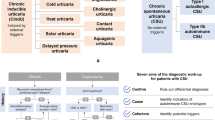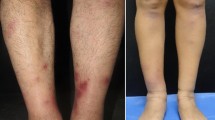Summary
The entry and persistence of phosphomycin in interstitial tissue fluid (ITF) were studied in 9 patients with normal renal function and 8 patients with varying degrees of renal impairment, all of whom received a single i.v. dose of 30 mg/kg. ITF was obtained from skin blisters produced by suction. The antibiotic followed a two-compartment open kinetic model. In patients with normal renal function, phosphomycin is incorporated rapidly into the ITF reaching a level of 60.4 µg/ml 60 min after administration. There was no statistically significant difference between the elimination rates from serum and ITF. The serum half-life of the slow disposition phase was 1.75 h in patients with normal renal function. There was a linear correlation between the elimination half-life of phosphomycin in serum and ITF in subjects with differing degrees of renal impairment.
Similar content being viewed by others
References
Ng PK (1980) Determining aminoglycoside dosage and blood levels using a programmable calculator. Am J Hosp Pharm 37: 225–231
Lisalo E (1977) Clinical pharmacokinetics of digoxin. Clin Pharmacokinet 2: 1–16
Van der Kleijn E, Schobben F, Vree TB (1980) Clinical pharmacokinetics of antiepileptic drugs. Drug Intell Clin Pharmacol 14: 674–685
Gram LF (1977) Plasma level monitoring of tricyclic antidepressant therapy. Clin Pharmacokinet 2: 237–251
Benet LZ (1972) General treatment of linear mammillary models with elimination from any comparment as used in pharmacokinetics. J Pharm Sci 61: 536–541
Levy G, Gibaldi M, Jusko WJ (1969) Multicompartment pharmacokinetic models and pharmacology effects. J Pharm Sci 58: 422–424
Notari RE (1980) Biopharmaceutics and clinical pharmacokinetics. An introduction. Marcel Dekker, New York Basel
Ritschel WA, Banarer M, Diaz D, Margary JB, Otero JD (1980) Analog computer monitoring and evaluation of a dosing nomogram for gentamicin based on the C'min Method: part I. Int J Clin Pharmacol Ther Toxicol 18: 425–430
Welling PG, Craig WA (1976) Pharmacokinetics in disease states modifying renal function. The effect of disease states on drugs pharmacokinetics. Benet LZ (ed) American Pharmaceutical Association, Washington, pp 155–187
Dettli L (1977) Elimination kinetics and dosage adjustment of drugs in patients with kidney disease. Prog Pharmacol 1: 17–23
Klotz U (1976) Pathophysiological and disease-induced changes in drug distribution volume: pharmacokinetics implications. Clin Pharmacokinet 1: 204–218
Reidemberg MM, Drayer DE (1978) Effect of renal disease upon drug disposition. Drug Metab Rev 8: 293–302
Bennett WM, Porter GA, Bagby SP, McDonald WJ (1976) Drug and renal disease. Livingstone, New York Edinburgh
Dominguez-Gil AA, Garcia MJ, Cepeda M, Lanao JM, Dominguez-Gil A (1981) Influence of acute renal impairment in the penetration of cefoxitin into interstitial tissue fluid in rabbits. Clin Ther 3: 413–424
Hendlin D, Stapley ED, Jackson M, Wallick H, Miller W, Chajet L, Kahan FM, Foltz EL, Woodruff HB, Mata JM, Hernandez S, Mochales S (1969) Phosphomycin a new antibiotic produce by strains of streptomyces. Science 166: 122–123
Kestle DG, Kirby WMM (1969) Clinical pharmacology and in vitro activity of fosphomycin. Antimicrob Agents Chemother 332–337
Kwan KC, Wadke DA, Foltz EL (1971) Pharmacokinetics of fosphomycin in man I: intravenous administration. J Pharm Sci 60: 678–684
Kiistala V, Mustakallio KK (1967) Dermo-epidermal separation with suction. Electron microscopic and histochemical study of initial events of blistering of human skin. J Invest Dermatol 48: 466–467
Garrod LP (1978) In: Ed. Reeves DS, Phillips I, William JD, and Wilse HR (eds) Laboratory methods in antimicrobial chemotherapy. Churchill Livingstone, London New York
Foster TS, Bourne DWA (1977) Use of a programmable handheld calculator for clinical pharmacokinetics. Am J Hosp Pharm 34: 70–75
Foltz EL, Wallick H (1969) Pharmacodynamics of phosphonomycin after intravenous administration in man. Antimicrob Agents Chemother: 316–321
Cadorniga R, Diaz M, Olay T (1977) Pharmacokinetic study of Fosfomycin and its bioavailability. Chemotherapy 23 (Suppl): 159–174
Garcia MJ, Dominguez-Gil A, Tabernero JM, Sanchez Tomero JA (1979) Pharmacokinetics of Cefoxitin in patients with normal or impaired renal function. Eur J Clin Pharmacol 16: 119–124
Meyers BR, Ribner S, Yancovitz S, Hirschman SZ (1976) Pharmacological studies with Cefamandole in human volunteers. Antimicrob Agents Chemother 9: 140–144
Binswanger U, Rouan MC, Lecaillon B, Bamatter F (1980) Pharmacokinetics of Cefotian in patients with impaired renal function. Abstracts (no 132) 2 nd. Mediterranean Congress of Chemotherapy, Nice. Richelme H (ed) Société Mediterranéenne de Chimiothérapie, Nice
Barrueco M, Garcia MJ, Otero MJ, Dominguez-Gil A, Martinez L, de Letona J (1981) Disposition of Cefoxitin in patients with pleural effusion. Clin Ther 3: 425–435
Farago E, Kiss IJ, Mihoczy L (1980) Data on sisomicin effect: Human pharmacokinetics and bacteriological studies. Int J Clin Pharmacol Ther Toxicol 18: 128–132
Madhavan T, Yaremchuk K, Levin N, Pohlod D, Burch K, Fisher E, Cox F, Quinn EL (1976) Effect of Renal failure and dialysis on the serum concentration of the aminoglycoside Amikacin. Antimicrob Agents Chemother 10: 464–466
Vicente MV, Olay T, Quecedo MCR, Rodriguez A (1979) Diffusion ofβ-lactam antibiotics and Fosfomycin to interstitial tissue fluid in rabbits. Chemotherapy 25: 329–335
Periti P, Mazzei T, Mini E, Nicoletti A, Lamanna A (1979) High dose Fosfomycin: Indications, tolerance and pharmacokinetics. Drugs Exp Clin Res 5: 373–377
Author information
Authors and Affiliations
Rights and permissions
About this article
Cite this article
Fernandez Lastra, C., Mariño, E.L., Dominguez-Gil, A. et al. The influence of uremia on the accessibility of phosphomycin into interstitial tissue fluid. Eur J Clin Pharmacol 25, 333–338 (1983). https://doi.org/10.1007/BF01037944
Received:
Revised:
Accepted:
Issue Date:
DOI: https://doi.org/10.1007/BF01037944




